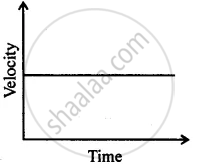Advertisements
Advertisements
प्रश्न
When will you say a body is at non-uniform acceleration?
उत्तर
- A body is said to have non-uniform acceleration if it travels in a straight path in such a way that its velocity changes at a non-uniform rate.
- i.e., the velocity of a body increases or decreases in unequal amounts in an equal interval of time.
APPEARS IN
संबंधित प्रश्न
Find the initial velocity of a car which is stopped in 10 seconds by applying brakes. The retardation due to brakes is 2.5 m/s2.
A motorcycle moving with a speed of 5 m/s is subjected to an acceleration of 0.2 m/s2. Calculate the speed of the motorcycle after 10 seconds, and the distance travelled in this time.
A cheetah starts from, rest, and accelerates at 2 m/s2 for 10 seconds. Calculate :
(a) the final velocity
(b) the distance travelled.
When a car driver travelling at a speed of 10 m/s applies brakes and brings the car to rest in 20 s, then retardation will be :
Which of the following could not be a unit of acceleration?
A bus increases its speed from 36 km/h to 72 km/h in 10 seconds. Its acceleration is :
Define velocity. State its unit.
When is the positive acceleration?
Can you suggest a real-life example about the motion of a body from the following velocity – time graph?

An electron moving with a velocity of 5 × 104 ms−1 enters into a uniform electric field and acquires a uniform acceleration of 104 ms–2 in the direction of its initial motion.
(i) Calculate the time in which the electron would acquire a velocity double of its initial velocity.
(ii) How much distance the electron would cover at this time?
